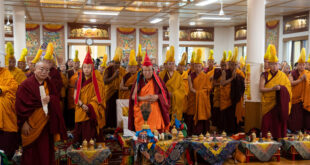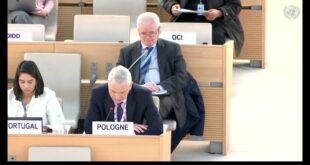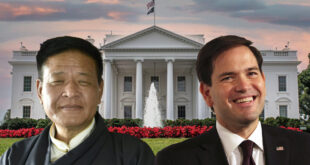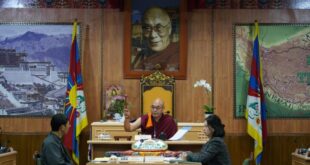One Heart, One Mind, One Universe
On May 8, 2011 His Holiness the Dalai Lama gave the Medicine Buddha empowerment and a public talk on “Peace Through Inner Peace.” Both of these programs were part of the theme “One Heart, One Mind, One Universe” of this visit to Minneapolis, which is co-hosted by the Center for Spirituality & Healing (CSH) at the University of Minnesota and the Tibetan American Foundation of Minnesota (TAFM).
The Medicine Buddha empowerment was hosted by TAFM and took place at the Mariucci Arena. Around 6000 people attended the session where His Holiness placed the Tibetan art of healing from a Buddhist perspective. Termed “A Tibetan Cultural and Spiritual Ceremony Promoting Personal and Societal Healing,” His Holiness began by first talking about the roles of the different religions in today’s society. He outlined the commonality of purpose of all religions saying they all have the same potential for unbiased compassion. He talked of the outreach Tibetan Buddhists have done with other religions.
His Holiness then gave an overview of Buddhism emphasizing on the need to study and practice the philosophy. His Holiness said the root of all problems in this could be traced to extreme self-centeredness. He suggested that serious Buddhist practitioner should meditate on the four foundation of mindfulness: mindfulness of body; mindfulness of feelings; mindfulness of mind; and mindfulness of Dharmas.
Bestowing the Medicine Buddha Empowerment, His Holiness, as per Tibetan Buddhist tradition, informed the audience that he had received this empowerment from both his tutors Taktra Rinpoche as well as Trijang Rinpoche.
His Holiness explained the nature of “blessing” and how it has to be looked at saying that the Tibetan term for blessing, Jinlap, was composed of two words literally meaning bringing about brilliance or majesty through transformation. He said the connotation was that something impure was being transformed through the power of brilliance to something pure.
His Holiness ended by reminding the gathering that mere recitation of prayers was not enough. He said that peace would not come through prayer; peace will come through action.
Prior to the afternoon public talk, His Holiness briefly addressed a luncheon for sponsors of the events. Among those at the luncheon was Congressman Keith Ellison.
His Holiness expressed his appreciation of the support that the local people have been rendering to the Tibetan community. He said although it was a small community over the years they have not only been able to eke a living for personally but also do something on the issue of Tibet.
His Holiness then explained briefly the nature of Tibetan Buddhism and the serious conversations with modern science. He said study of science has been introduced in Tibetan monasteries in India. His Holiness said that while Tibetan Buddhist religion was for individual believers Tibetan culture was something that was meant for society. His Holiness included Tibetan medicine in this saying it was a holistic treatment method. His Holiness appreciated the University of Minnesota’s involvement in research on the Tibetan form of healing.
In the afternoon the event began at the same venue with welcome remarks by Ms. Mary Jo Keitzer, director of the Center for Spirituality and Healing of the University of Minnesota, and Dr. Tsewang Ngodup, President of the Tibetan American Foundation of Minnesota.
Thereafter,

in his welcome remarks talked about a variety of events, including exhibitions and conference that were being organized on Tibet in conjunction with the visit of His Holiness. Announcing the honorary Doctor of Humane Letters to His Holiness the Dalai Lama, President Bruininks and a Regent conferred the honorary degree t His Holiness. The citation said, “Doctor of Humane Letters. His Holiness the 14th Dalai Lama. Native of Taktser, Amdo; temporal and spiritual leader of Tibet and its government in exile, 1950-present; recipient of the Geshe Lharampa degree, honours, Jokhang Temple, Lhasa, 1959; author of a draft democratic constitution, 1963, and Five Point Peace Plan, 1987, for Tibet; proponent of scientific research through the Mind and Life Institute, 1987-present; Nobel Peace Prize recipient, 1989; initiator of the first direct, democratic elections for a representative Tibetan government, 1992 and 2001; author of more than 72 books, including the New York Times bestseller The Art of Happiness; recipient of the Congressional Gold Medal, 2007; founder of The Dalai Lama Trust to support the welfare of the Tibetan people and preserve their culture and heritage, 2009—
“Because you demonstrate that with quiet determination, a compassionate heart, and a curious mind, even the path of a simple Buddhist monk can lead to a place of global understanding and purpose; because your teachings reveal all we share – from the fundamental desire for happiness and freedom, to the impact we have on our planet; because you remind us that peace is attained not simply when wars cease, but when basic human needs are met and basic human rights are respected; and because your embrace of scientific inquiry into the life of the mind has illuminated the symbiotic relationship between health and well-being – inspiring the commitment of the University of Minnesota to transform the delivery of health care, not only through research and clinical innovation, but also by advancing understanding of how diverse cultural beliefs and healing practices can improve health and the human condition –
“The Regents of the University of Minnesota, upon recommendation of the faculties, confer upon Tenzin Gyatso, His Holiness the 14th Dalai lama, the degree of doctor of humane letters, honoris causa. — “Conferred on May 8, 2011.”
Peace Through Inner Peace
His Holiness then gave his public talk. He first thanked the University for the honorary degree, for which he did not have to study. He said in this second visit after ten years people still showed genuine kindness to him.
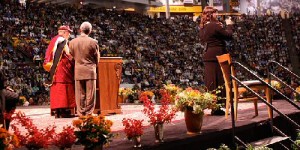
His Holiness talked about the importance of educational institutions like the University incorporating secular moral ethics in the curriculum outlining his thoughts on why this was needed. He said fundamentally all human beings were same wanting a happy life. He said the modern education system began over a thousand year ago in Europe. At that time the Church took upon itself the role of promoting inner peace. Over the years, the influence of the Church decline and family values also declined. Therefore, now there was the need for the educational institutions to step in to teach people on inner values.
He said the 20th century has been the most important century in human history. It saw innovations in science and technology. At the same time it also saw lot of bloodshed and the use of nuclear bombs and the subsequent impact of these. Thus the marvelous development brought more fear. The need was therefore to promote those ideals that will generate compassion, warm heartedness, strengthen inner values, and build trust and friendship.
His Holiness explained three main reasons for developing inner values, namely common experience, common sense and through scientific evidence. He said when a child is born the mother provides affection that has an impact later on. Here His Holiness recalled the kindness of his mother and said that he learned from her about warm heartedness. He said that those individuals who received maximum affection from their mother when young developed much deeper inner calm when they are grown up. Similarly, those individuals who did not receive affection and who may even have suffered abuse had a negative outlook when grown up.
His Holiness said extreme self-centered attitude and narrow vision not only did not enable the development of inner peace but also could be harming people physically. He recalled a presentation by a scientist at a conference during which the scientist revealed that individuals who tend to use “I”, “Me”, and “My” were seen to be more liable for heart attack. His Holiness said although the scientist did not explain the reason he felt that this was because of self-centeredness.
His Holiness therefore said compassion was the key factor for good physical health as well as for a positive community. He suggested that there is a need for a project to research on how to tackle these values.
His Holiness outlined three ways in which the promotion of fundamental human values could be done. These were theistic, non-theistic, and secular ethics way.
In the theistic approach there is belief in God the creator and the total submission to God that encourages individuals to cultivate human values. He recalled an event in Jerusalem when a Jewish teacher related an experience. The teacher had asked his students, composed both of Palestinians and Jews, to view their detractors in the image of God. Subsequently, the Palestinian students had told him how they found his message useful as their discomfort disappeared while crossing Israeli check posts. His Holiness also said his Muslim friends have also said that everyone should extend their love to all creatures. He said he found these logical.
For those individuals who follow non-theistic religions, belief in the law of causality where your action determines the outcome was very helpful, His Holiness said. If you do good, you will have a good outcome is the belief that encourages people to develop positive values.
His Holiness said if these religious approaches had to be used then new questions arise as to which religion to adopt, etc. Therefore, he felt that there was the need of a third approach that did not have to touch on religion. He said secular ethics was the way. He said he was using secular here in the way it is promoted in India: not rejection of religion but equal respect to all religions.
His Holiness said from among the different civilizations like the Egyptian, Chinese and Indus Valley civilizations, the Indus Valley region resulted in the growth of different schools of thoughts in India. Referring to one such school that propagated nihilism that denied God, His Holiness said that its propagators were still respected in India and called Rishis or sages.
His Holiness concluded by saying that he appreciated the University of Minnesota’s effort in incorporating the study of spirituality. His Holiness’ visit coincides with the official launch of the Tibetan Healing Initiative (THI) at the University’s Center for Spirituality & Healing. The new THI initiatives will include research on the benefits of blending Tibetan healing with conventional health practices and integrating Tibetan practices into regional clinic and hospital settings.
His Holiness mentioned that so far the University of Wisconsin in Madison, Stanford University and Emory University had programs researching the impact of spirituality and science. He jokingly mentioned that he would be coming back after some years to see how the University of Minnesota’s program had developed.
His Holiness then answered some questions from the audience. The first one was about His Holiness’ feeling on China detaining a scholar. His Holiness responded that unfortunately on account of hardline thinking China was tightening control. In the process, scholars and intellectuals, who are its treasure, are being detained or kept under house arrest. His Holiness felt this situation could not go for long. If one intellectual is detained a new one will come up, he added. Another question related to his views on the Internet’s development. His Holiness said this was wonderful as this provided more opportunity for people to get all round information from different sources. When asked whether he felt the world was getting better or worse, His Holiness responded that it was getting better and recalled his conversation with the late British Queen Mother in 1996 during which he sought her view of the 20th century since she had lived for most of it. The Queen Mother had unhesitatingly responded that the world was getting better because in the beginning of the 20th century there was no concept of human rights and self-determination, which came under active public awareness in the latter part of the century.
His Holiness also related his own experience why he felt the world was getting better. He said unlike in the past there is awareness about the importance of ecology, including the coming up of political parties like the Green Party; scientists are seriously looking at the mind as opposed to their merely limiting themselves to matters that could be measured or calculated; religious summits like the Assisi Summit by Pope John Paul II (held in 1986) that are transforming the thinking from “one faith, one truth” to “many faiths, many truths;” politicians are talking about “compassion;” public calls on ban on nuclear weapons, etc.
His Holiness concluded by saying that people needed to think deeper and not just superficially. He talked about inner beauty being more important than external beauty.
On Saturday, Minnesota Governor Mark Dayton paid a courtesy call on His Holiness. Minnesota has the second largest concentration of Tibetan Americans in the United States after New York.
His Holiness will have his next program in Dallas in Texas at the Southern Methodist University on May 9, 2011.

